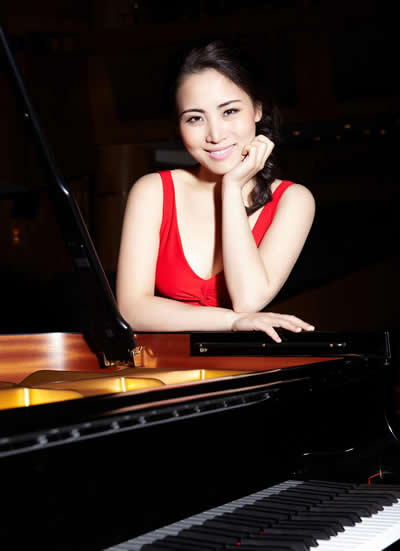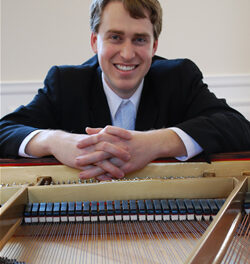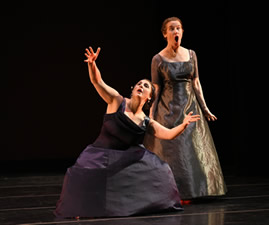In addition to performing the title piece of the program, Tchaikovsky’s Piano Concerto No. 1, the NC Symphony first took the audience in Raleigh’s Meymandi Concert Hall on a journey through two intriguing Strauss works. Guest conductor Eugene Tzigane led the orchestra with fervent and infectious energy, and the result was a fascinating array of contrasting moods and textures.
Strauss’s Don Juan Op. 20, is a somewhat abstract character study on the life and death of the title character. It begins with a noble fanfare and melody led by the brass section, leading into a romantic, slower section. Here, a romantic melody is played in a sort of canon between strings and woodwinds; it is almost melodramatic, reminding the audience of the character-driven concept of the piece. One of the highlights of Don Juan is the calm and melodious oboe solo, contrasting greatly to more urgent passages. Of course, this calm is eventually disrupted too, with strings rapidly crescendoing to a similar restatement of the original theme. Startlingly, right before the completion of the final cadence, there is a dramatic pause. After a soft, low drone of strings, the piece closes with a quiet but firm unison note, signaling the abrupt and final death of Don Juan.
The second Strauss tone poem, Tod und Verklärung (Death and Transfiguration) Op. 24, also clearly explores death, but with a different subject and story. Here, there are clear sections illustrating the reverie of a sick man right before he dies and then his transcendent experience after death. First, the sickroom is portrayed by solemn minor chords suspended by the strings, with a recurring rhythm that imitates the man’s irregular and faltering heartbeat. From this texture, hope begins to enter through a flowing harp and hopeful flute solo, but then a slow rumbling bass and chromatic movement indicates the character’s crippling battle with pain. Then, only treble strings are suspended to transition into the reverie, with a calm and comforting flute solo. Just before the depiction of the man’s death, his reverie swells to grand, full chords that rise, but are never quite fulfilled. The irregular rhythm reappears, bringing back a quiet and solemn mood. However, transfiguration occurs after death, a glorious ascension signaled by a hopeful crescendo. Though quieter, this cadence is completed, landing on a consonant and peaceful chord. Even after the sound died away, Tzigane waited for several moments of silence before releasing the orchestra, and the effect was breathtaking.
Di Wu‘s performance of Tchaikovsky’s first piano concerto was breathtaking as well; her fluid yet precise motion was particularly fascinating. The first movement, Allegro non troppo e molto maestoso, begins with a fanfare-like orchestra introduction, followed by the piano’s entrance against pizzicato strings. A restless and capricious piano motive brings a mysterious mood that the orchestra picks up as well. This is a prime example of the well-planned and well-executed interaction between the piano and the orchestra. Throughout the concerto, Wu navigated this interaction by expertly bringing the texture of the entire orchestra to her solo instrument. This created seamless transitions through the rapidly changing moods of the first movement in particular. Contrasting to what came before, the first movement concludes with a furious rush to a strong concluding cadence.
The calmer second movement, Andantino semplice, begins with a lyrical flute melody that is reminiscent of a love song. In triple meter, this movement is also waltz-like. Shortly after, the piano flows into a faster section with syncopated accents. Wu navigated fascinating waterfalls of notes that seemed effortless but required expert precision. The movement returns to the slower tempo to conclude with a warm sense of peace. This is disrupted by the contrasting entrance of the third movement, Allegro con fuoco. Syncopation through accents appears again, this time even more dramatic and wild. There are two main themes in this movement: first, a carefree dance in fast triple meter, and a contrasting lyrical melody. Transitions between the two were often smoothly led by the piano. However, the movement concludes with the capricious dance texture, adding a melody that soars to a triumphant close.
After tremendous applause, Wu returned to play an encore: Debussy’s abstract and impressionistic “Feux d’artifice” (“Fireworks”). This piece requires constant motion, often with a treble melody shining through dissonance. Most notably, Di Wu’s execution of playing extremely soft passages was simply amazing. Her quiet dynamics were just loud enough to be heard in the concert hall, but they were perfectly balanced. This intriguing encore was a fine choice to conclude a night of fascinating music.
For more information on the guest conductor, click here.
And the pianist has her own YouTube channel, available here.
This program was given in Chapel Hill on October 23 and will be repeated in Raleigh on October 25. For details, see the sidebar.













